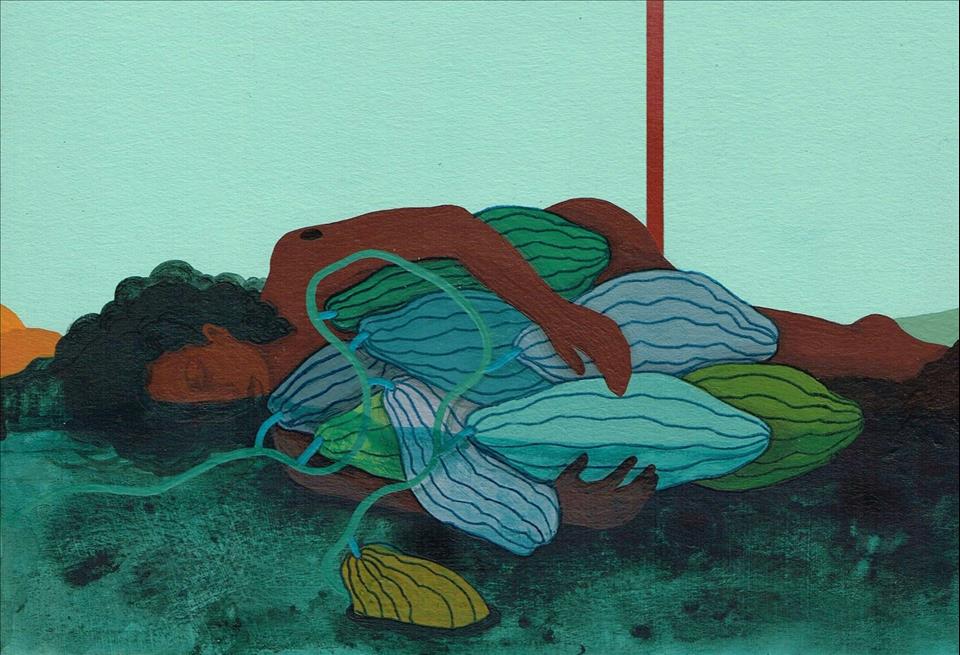
The Land Sings Back: A Gorgeous Exhibition Of Drawings Inspired By Ecofeminism
Thirteen artists with ancestral lands in south Asia, Africa and the Caribbean are subverting the role that sketching and drawing have played in conquest and colonialism. Instead, they have reimagined it as a way to reclaim indigenous knowledge for environmental justice. Drawing on archival research, soundscapes, zines, ceramics, found objects and ephemera, the work on show dissolves the boundaries and lines between various media, questioning the institutionalisation of knowledge.
The exhibition draws on the concept of ecofeminism, first coined by French writer Françoise d'Eaubonne in her 1974 book Feminism or Death. Ecofeminism maintains that patriarchy and colonialism are inherently interlinked. The subjugation of women and marginalised people, which has severed their connection to the lands and the oppression of their myths and stories, has created an imbalance between nature and humans.
Peeple ka ped (Peepal Tree) by Lado Bai (early 1980s). Courtesy of Rob Dean Art
The exhibition opens with the work of Lado Bai, a Bhil artist from Madhya Pradesh in India. Bai combines traditional motifs with contemporary symbolism to show a deep connection to the natural world. The Bhil religion is deeply rooted in animism. Animism is the belief that everything from trees and rivers to rocks and animals possesses a spiritual essence and that these entities must be respected through rituals and offerings.
In the 1901 census, 97% of Bhils identified as animists, and they retain this connection through stories and folklore. This forms the basis of Bai's work. Like so much of indigenous art from India, there is a deceptive simplicity to her work, but within the dots and lines, there is a deeper story of ancient knowledge. Every painting presents an episode in the larger story of Bhil ritual and tradition.
Another Indian artist on display is Manjot Kaur. Kaur reimagines the historical miniature paintings from Mughal art and Rajasthani tradition and uses anthropomorphism to challenge black-and-white thinking. It's a hopeful response to the climate crisis and extinction. Not merely content with representing the traditional stories and rituals, Kaur is reimagining the mythologies for a post-queer world – a world where people no longer feel the need to define themselves through queer labels – or even a post-human one.
The Convocation of Eagles (detail) by Manjot Kaur (2025). Manjot Kaur
This series is titled Chthonic Beings. The title comes from the Greek mythological creatures of the underworld. These monstrous looking beings are gods of fertility – but also of death. Both coexist, fluidly merging into one another. And so, here too, Kaur decentres the human, instead imagining many of the local Indian species such as blackbuck and great Indian bustard playing the roles of protectors and care givers.
Whose truth and whose land?Every artist in this exhibition is unique in their approach and response, but drawing is the thread that weaves their stories together. There are broad questions at play: what does a line on the paper mean? Whose labour is hidden? Who has the power to imbue meaning in these lines?
Historically, lines have been drawn to divide people, marginalise them and push them away from the mainstream of society where power lies. Here, the lines are doing the opposite. They are discordant, but only to challenge the disharmony and oppression of the past and the present.
The lines are uncomfortable at times, as in Anupam Roy's work, which uses satirical imagery and protest posters to draw attention to the land rights movement against the many mining projects in rural Bengal. In February 2025, local activists from west Bengal's Birbhum district demanded the mining work in the Deocha-Pachami-Dewanganj-Harisingha coal block be cancelled.
Time is Sloshing 2 by Anupam Roy (2023). Courtesy the artist & Project 88, Mumbai
It led to the displacement of thousands of indigenous people from their lands. Roy's drawings demand urgent action for the subaltern subjects (those people who have been historically marginalised and excluded from the dominant power structures) and their precarious condition in the contemporary capitalist system.
But the larger question in Roy's work is the matter of truth, and whose truth we see represented in images around us. Truth and propaganda are very much on the same axis, as we are seeing today in our current political climate.
The Land Sings Back is beautifully curated by Natasha Ginwala, artistic director of Colomboscope. And it is an emotional experience too, which left me with more questions than answers. But then, that is what good art always does.
The Land Sings Back is on at Drawing Room, London until December 14 2025
Looking for something good? Cut through the noise with a carefully curated selection of the latest releases, live events and exhibitions, straight to your inbox every fortnight, on Fridays. Sign up here.
This article features references to books that have been included for editorial reasons, and may contain links to bookshop. If you click on one of the links and go on to buy something from bookshop The Conversation UK may earn a commission.

Legal Disclaimer:
MENAFN provides the
information “as is” without warranty of any kind. We do not accept
any responsibility or liability for the accuracy, content, images,
videos, licenses, completeness, legality, or reliability of the information
contained in this article. If you have any complaints or copyright
issues related to this article, kindly contact the provider above.


















Comments
No comment